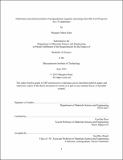Fabrication and characterization of perpendicular magnetic anisotropy thin-film CoCrPt grown on a Ti underlayer
Author(s)
Kane, Margaret Marie
DownloadFull printable version (3.117Mb)
Other Contributors
Massachusetts Institute of Technology. Department of Materials Science and Engineering.
Advisor
Caroline Ross.
Terms of use
Metadata
Show full item recordAbstract
CoCrPt has potential applications as a memory storage technology because of its perpendicular magnetic anisotropy (PMA) characteristics. An underlayer can be used to ensure the out-of-plane magnetization required for PMA functionalities. Ti, with a lattice constant of a = 2.95 Å can be used to encourage uniaxial c-axis growth in CoCrPt (lattice constant a ~/= 2.55 Å, dependent on exact composition). In this report, varying thicknesses of Ti (t = 0, 20, 40, 60, 70, 80, 90, 100nm) and CoCrPt (t = 50, 75, 90, 100, 125, 150nm) were sputtered onto naturally oxidized silicon substrates. Using various characterization methods, these films were investigated in order to better understand the system. The exact composition of the CoCrPt films was found to be approximately Co₆₀.₂Cr₁₆.₄Pt₂₃.₄, with a Curie temperature of about 600 °C. The addition of a Ti underlayer resulted in an increase in coercivity to approximately 1250 Oe for t > 60nm. However, switching field distribution and saturation magnetization appear to be independent of underlayer thickness. All samples show evidence of out-of-plane growth and the roughness of the films increases until it also plateaus at about t = 60nm. When CoCrPt thickness is varied on a constant Ti underlayer, the PMA properties of the materials decrease with increasing thickness due to increased disorder and potential relaxation of the lattice in thicker films. The switching field distribution shows a significant increase, implying that a thicker film has a more homogenous distribution of grain sizes. XRD peaks confirm out-of-plane growth and suggest a trend of increasing c lattice constant as the thickness of the film increases.
Description
Thesis: S.B., Massachusetts Institute of Technology, Department of Materials Science and Engineering, 2015. This electronic version was submitted by the student author. The certified thesis is available in the Institute Archives and Special Collections. Cataloged from student-submitted PDF version of thesis. Includes bibliographical references (pages 57-58).
Date issued
2015Department
Massachusetts Institute of Technology. Department of Materials Science and EngineeringPublisher
Massachusetts Institute of Technology
Keywords
Materials Science and Engineering.